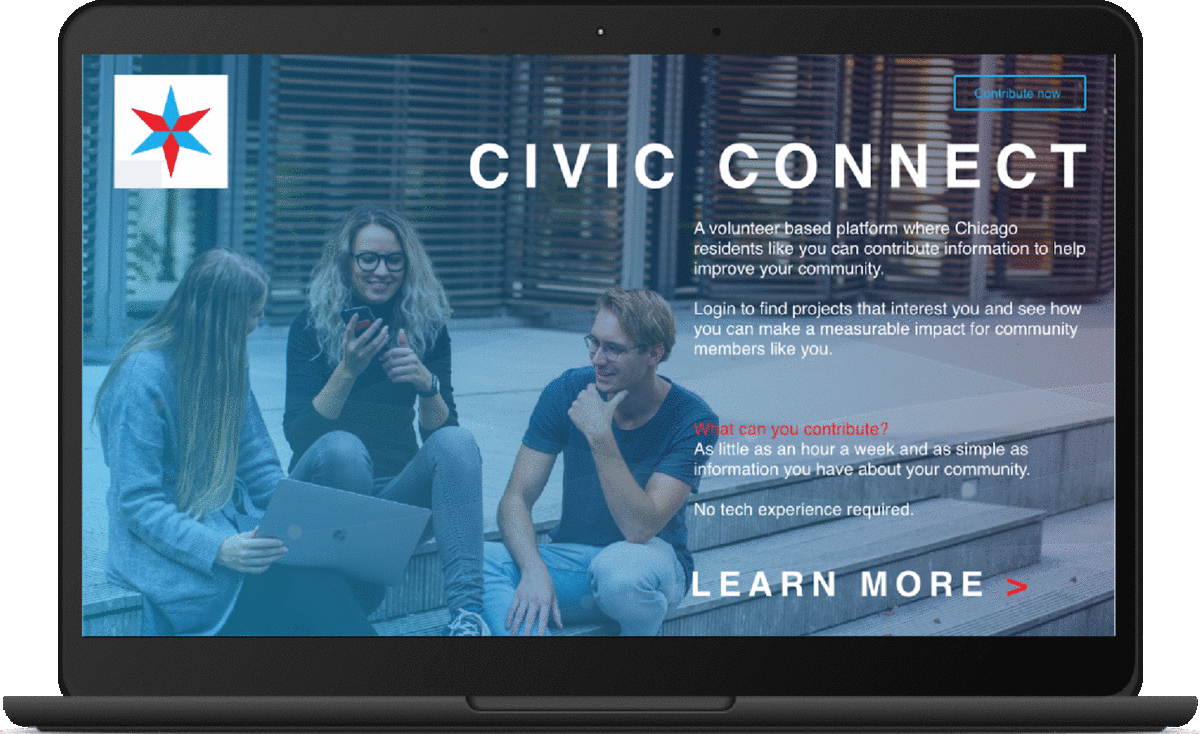How might we bridge the gap between local residents and civic technologists and enable collaboration in addressing challenges in Chicago communities?





Fostering
Community Engagement
with the City of Chicago
Equipping Chicagoans for Civic Engagement
The City of Chicago presented my team with the challenge of leveraging civic tech to engage residents in their local community. The Civic Tech community in Chicago is well connected internally and strives to build a diverse range of impactful projects that set out to make a difference in the lives of the city's residents. However, there is a barrier for new and local residents who aren't well-versed in tech skills to become involved in this community.
Through Civic Connect, a digital connective platform, we identified an opportunity for socially and civically aware residents to become involved in the community of civic tech by better sharing their experiences of living in the city towards relevant projects through simple, doable tasks.
Service Design Studio, Northwestern University, Winter 2019

Civic Technologists
Eager to build products that can create impact in community

Residents
Hope to see and help bring impactful change in their community

RESEARCH

My team attended various sessions of Chi Hack Night, a free, weekly event in Chicago for civic technologists to build, share and learn about tools to create, support, and serve the public good. It is attended by designers, academic researchers, data journalists, activists, web developers; all curious citizens who want to make our city more just, equitable, transparent and delightful to live in through data, design and technology.
Immersive Research
We observed the event as attendees and took note of the people, actions, behaviors, interactions, artifacts, and the environment.
User Interviews
We spoke with civic technologists of different backgrounds about their involvement and motivation to create impact in this community.
Focus Groups
We participated in breakout groups for different civic tech projects to understand how projects are executed and delivered.

MAPPING CURRENT USER JOURNEY

SIMPLIFIED JOURNEY MAP
MAPPING STAKEHOLDERS

EXISTING BARRIERS TO CONTRIBUTION

Problem Finding
Barrier: Finding & reaching out to communities to learn about their needs
“It’s always good to go out to the community, but we don’t have the time or resources to do that.”
User Testing
Barrier: Accessing users to continuously test and refine their product
“We can only tell if what we build is useful by getting feedback from real community members.”
Post-Launch
Barrier: High cost to launch and maintain platform without consistent usage
“We were lucky because the organization we worked with maintains it now.”

Engagement
Barrier: Wants to increase their civic engagement but needs to see that they have impact
“The best way to see change in the community is to be part of it.”
Product Testing
Barrier: Low technology skills and not informed on how to get involved
“I want to help, but I don’t feel like I know anything about [getting involved].”
Post-Launch
Barrier: Maintaining and monitoring engagement over extended time
“It can be easy to drop off staying involved without some kind of reminder.”
IDEATING
My team conceptualized Civic Connect, a platform that leverages a connective digital portal to bridge Chicago residents to the civic tech community by presenting active projects that need user feedback and testing to continue development through delivery.
Key Features
-
Allow civic technologists to post active projects that need resident validation and input
-
Enable community residents to search for and select active civic tech projects of interest
-
Empower residents to complete simple usability tasks to contribute to civic tech projects
-
Motivate residents to continue contribute information about their relevant experiences through visualized measures of engagement with the civic tech projects they interact with
DESIGN PRINCIPLES
Meet residents where they are
Empower civic technologists to build with, not for
Accessible to people without tech skills
Low-cost of maintainance
Measurable engagement
SERVICE STORYBOARD









WIREFRAMING









USER TESTING
Approach
We visited public spaces such as public libraries and town halls in communities for which civic technologists were developing projects and spoke with local residents to share our civic connect wireframes and gather feedback.
Goal
-
Test usability of civic connect portal design
-
Understand resident interactions with portal features such as project selection, task completion, monitoring engagement
-
Evaluate likeliness of resident to contribute to projects
Findings
-
Residents liked simplicity of task completion
-
Residents reacted positively to being able to measure engagement with portal to motivate continuation of contribution to projects
CIVIC CONNECT MOCKUP

SERVICE BLUEPRINT

THE TEAM

Christy Zhang
Neha Kodi
Faye Gong
Siqi Chen

IMMERSIVE RESEARCH
My team attended multiple civic tech events such as Chi Hack Night to better understand the interactions and motivations of the members of this community. We participated in group breakout sessions of different projects to explore their range of civic areas and learn how they impact Chicago residents.

NEEDFINDING
We identified key players in this space past civic technologists and Chicago residents to various communities such as public libraries, town halls, and high school tech programs. With these stakeholders in mind, we explored their needs to conceptualize how to better connect the different groups to meet where they are.

SERVICE BLUEPRint
Through the needs and insights derived from our research and synthesis, we developed a service blueprint to visualize the digital platform we conceptualized. We mapped out the multiple stakeholders, points and artifacts of interactions, necessary actions, and methods of delivery.

USER TESTING
I helped create numerous prototypes of digital platforms that could help engage Chicago residents to be civically engaged in their communities by sharing their current experiences with city resources, infrastructures, and ongoings. By testing these prototypes we were able to iterate towards a developed mockup.
